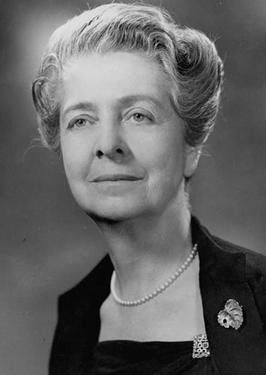
This year, Miriam’s cup honors Dr. Rita Levi-Montalcini, a dedicated scientist, Nobel Prize winner, and Holocaust survivor, who died in 2012 at the age of 103. She was the first living Nobel laureate to reach a 100th birthday.
Rita Levi-Montalcini was born in 1909 in Turin, Italy. Together with her twin sister, Paola, she was the youngest of 4 children. Her parents both traced their roots as Italian Jews to the Roman Empire. Her father, Adamo Levi, was an electrical engineer and mathematician, and her mother, Adele Montalcini, a painter, a career path her twin sister, Paola, also followed. She describes her father as the undisputed master of the house, and her mother as serene and passive, placing her own artistic talents secondary to her role as a mother and wife. Observing her mother’s submissive role, Levi-Montalcini concluded that a creative career for women was incompatible with marriage, so she never did so.
Although Rita worked hard in school, she received only a limited secular education. At age 20, her former governess Giovanna was diagnosed with cancer. This news shocked Rita and influenced her to resume her studies to become a doctor. Although her father discouraged his children from higher education, as he feared it would disrupt their lives as wives and mothers, he eventually supported Levi-Montalcini’s aspirations to go to medical school. After a program of remedial studies, she was accepted at Turin School of Medicine. While in medical school, Levi-Montalcini studied with Guiseppe Levi, a leading neurohistologist, who also mentored her research after she graduated.
Levi-Montalcini’s academic career was cut short in 1938 by Mussolini’s introduction of laws in Italy barring Jews from academic and professional careers. This only made Levi-Montalcini even more determined to continue her research. First, she continued her laboratory work in Belgium, but fear of Nazi invasion led her family to return to Italy. She made her bedroom into a secret laboratory and obtained fertilized chick embryos from local farmers, claiming that she needed fertilized eggs for better nutrition for her children. Using surgical equipment fashioned from sewing needles and tweezers, she was able to remove and graft limbs onto the embryos and observe the response of spinal motor neurons. As an additional benefit, the remnants of her experiments could usually be eaten by the family afterwards! In 1943, the family went underground in Florence after the Nazis invaded Northern Italy. At the end of the war, Levi-Montalcini worked as a medical doctor in a war refugee camp near Florence.
In 1947, Levi-Montalcini accepted an invitation to Washington University in St. Louis to study with Professor Viktor Hamburger, an experimental embryologist. Hamburger’s mentorship as chair of the zoology department helped her research career to flourish, and she remained at Washington University for 30 years. In 1958, she became a full professor, and in 1962, established a research unit in Rome, dividing her time between there and St. Louis.
Levi-Montalcini’s research discoveries changed the traditional belief that the nervous system was rigid and unchangeable, revolutionizing the study of neural development. She postulated the existence of chemical factors in normal tissues or tumors that could promote survival of immature nerve cells and lead to their differentiation and development, known as the neurotrophic hypothesis. Subsequently, she collaborated with Stanley Cohen, a biochemist, to isolate nerve growth factor, or NGF.
Decades after their initial discovery, neurotrophic factors like NGF have been shown to have an impact beyond developing neurons. In the adult brain, nerve growth factors have the ability to convert new experience into stronger neural connections that mediate learning, memory, and nerve regeneration. In fact, a positive feedback loop is postulated, where active brain cells also induce the production of more trophic molecules.
In 1986, Levi-Montalcini and Stanley Cohen shared the Nobel Prize in physiology or medicine for their identification of nerve growth factor. This made her the fourth Nobel Prize winner to come from Italy’s small but very old Jewish community. She received numerous other awards and honors, including the Albert Lasker Award for Basic Medical Research, election to the U.S. National Academy of Sciences, and the National Medal of Science, the highest American scientific honor. In 2001, at the age of 92, she was appointed as a Senator for Life by the Italian President.
Levi-Montalcini kept a strict and rigorous work schedule, right up to her death, publishing her last paper in the year that she died. In addition to her scientific achievements, she was active in cultural, political and social affairs. Levi-Montalcini felt strongly about supporting women in her own lab and mentored many young women scientists. In addition, she created the Levi-Montalcini Foundation to grant scholarships and promote education programs worldwide, particularly for women in Africa.
In her autobiography, “In Praise of Imperfection,” Levi-Montalcini documents her struggle and determination to become a scientist, as a Jewish woman in Europe during World War II. She affirms her belief that the even the most complex neural system, the human brain, develops in response to its environment: “It is imperfection—not perfection that is the end result of the program written into that formidably complex engine that is the human brain, and of the influences exerted upon us by the environment and whoever takes care of us during the long years of our physical, psychological and intellectual development.”
